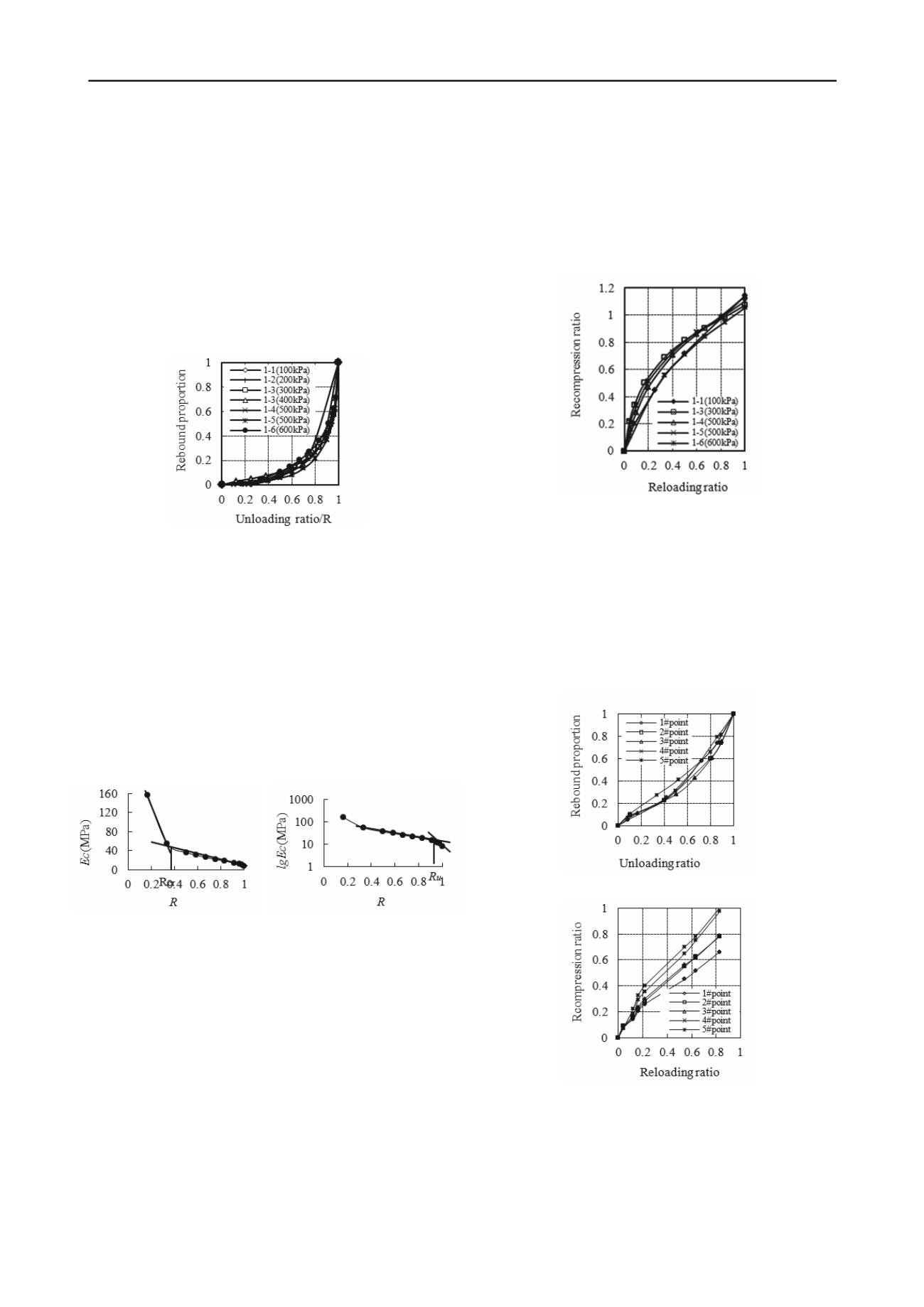
2874
Proceedings of the 18
th
International Conference on Soil Mechanics and Geotechnical Engineering, Paris 2013
rebound deformation and recompression deformation, such as
the relation curves of unloading ratio-rebound proportion, the
relation curves of unloading ratio- modulus of resilience, the
relation curves of reloading ratio-recompression ratio etc.
(1) The relation curves of unloading ratio-rebound proportion
In the process of unloading, figure 2 shows that: i) as the
unloading ratio is less than 0.4, the rebound deformation is less
than 10% of the total rebound deformation; ii) as the unloading
ratio increases to 0.8, the rebound deformation is about 40% of
the total one; iii) as the unloading ratio increases from 0.8 to 1.0,
the rebound deformation is about of 60% of the total one. So
unloading ratio is the key influencing factor of rebound
deformation.
Figure 2. The relation curves of unloading ratio-rebound
proportion of clay soil sample
(2) The relation curves of unloading ratio-modulus of resilience
The modulus of resilience is not a constant, see Figure 3. It
varies with the unloading ratio and exhibits three-phase
character
istics. For the soil of the same depth, the modulus of
resilience is varied according to the excavation depth. The
relation curves of R-E
c
can be divided into two lin
e segments,
see figure 3(a), and the unloading ratio of intersection of the two
line segments can be defined as critical unloading ratio
R
cr
.
When
R
<
R
c
r
,
E
c
increases sharply and rebound deformation
could be negligible. The relation curves of
R- lgE
c
also can be
divided into two line segments approximately, see figure 3(b),
and the intersection point of the two line segments can be
defined as limit unloading ratio
R
u
. When
R
>
R
u
,
E
c
decreases
sharply and the most rebound deformation occurs.
(a)
(b)
Figure 3. The relation curves of
R-E
c
and
R-lgE
c
of clay soil sample
The relation curves of unloading ratio-modulus of resilience can
be used to determine the calculation depth of rebound
deformation. In calculation, the depth of
R
c
r
can be calculated.
The rebound deformation beneath the depth is negligible, and
rebound deformation of this depth can be calculated. The
rebound deformation result meets the requirments of
engineering.
2.2 The Law of Recompression Deformation
(1) The relation curves of reloading ratio-recompression ratio
[3]
In the process of recompression, the curves of reloading ratio-
recompression ratio of clay soil, see figure 4, shows that: i) as
the reloading ratio
R
’ is 0.2, the recompression deformation is
about 40% ~60% of rebound deformation; ii) as the reloading
ratio increases to 0.4, the recompression deformation is about
70% of rebound deformation; iii) as the reloading ratio
increases to 0.6, the recompression deformation is about 90% of
rebound deformation; iv) as the reloading ratio reaches 0.8, the
recompression is roughly euqal to the rebound deformation; v)
for this kind of soil, as the reloading pressure is equal to the
unloading pressure, the recompression deformation is 1.2 times
to the rebound deformation. A large amount of testing data
show that, the recompression deformation is not equal to the
rebound deformation in value as the reloading ratio is equal to
1.0. Generally the recompression deformation is larger, and the
increase proportion of deformation varies with different kind of
soil
[4]
.
Figure 4. The curves of reloading ratio-recompression ratio of clay soil
2.3 Verification by Model experiment
In order to verify the law of rebound and recompression, the
model experiment was
carried out in the laboratory of Institute
of Foundation Engineering, China Academy of Building
Research. In the model experiment, soil deformation was
monitored during excavating and backfilling. The dimension of
the test pit is 13.0m×5.3m, the excavation depth is 3.5m, and
the backfilling depth is about 3.5m. Rigid measure points were
installed into the soil in different depth to measure the
deformation during the model experiment
[1, 5, 6]
.
Figure 5. The curves of unloading ratio-rebound proportion of soil at the
bottom of excavation
Figure 6. The curves of reloading ratio-recompression ratio of soil at the
bottom of excavation
The curves of unloading ratio-rebound proportion of soil at the
bottom of excavation, see figure 5, reflect the similar law of
rebound deformation with curves of soil tests, but the curves are
relatively flat, compared with the curves of soil tests.
In the process of backfilling, the curves of reloading ratio-
recompression ratio of soil show as figure 6. The recompression
deformation of soil can be divided into two line segments, and
the reloading ratio of the intersection point of the two line


